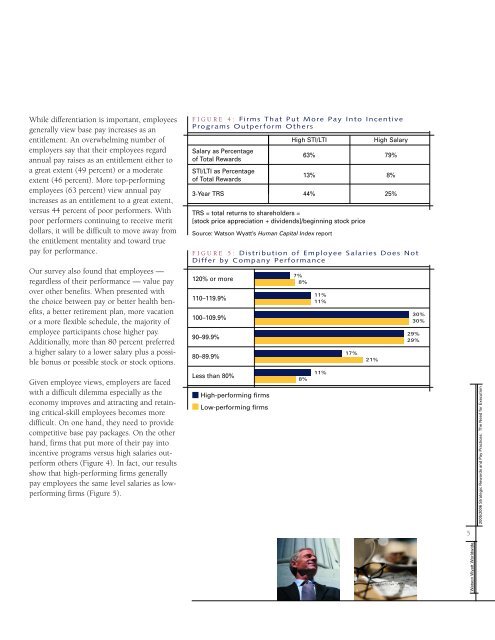The Need for Execution - San Antonio Compensation Association
The Need for Execution - San Antonio Compensation Association
The Need for Execution - San Antonio Compensation Association
You also want an ePaper? Increase the reach of your titles
YUMPU automatically turns print PDFs into web optimized ePapers that Google loves.
While differentiation is important, employees<br />
generally view base pay increases as an<br />
entitlement. An overwhelming number of<br />
employers say that their employees regard<br />
annual pay raises as an entitlement either to<br />
a great extent (49 percent) or a moderate<br />
extent (46 percent). More top-per<strong>for</strong>ming<br />
employees (63 percent) view annual pay<br />
increases as an entitlement to a great extent,<br />
versus 44 percent of poor per<strong>for</strong>mers. With<br />
poor per<strong>for</strong>mers continuing to receive merit<br />
dollars, it will be difficult to move away from<br />
the entitlement mentality and toward true<br />
pay <strong>for</strong> per<strong>for</strong>mance.<br />
Our survey also found that employees —<br />
regardless of their per<strong>for</strong>mance — value pay<br />
over other benefits. When presented with<br />
the choice between pay or better health benefits,<br />
a better retirement plan, more vacation<br />
or a more flexible schedule, the majority of<br />
employee participants chose higher pay.<br />
Additionally, more than 80 percent preferred<br />
a higher salary to a lower salary plus a possible<br />
bonus or possible stock or stock options.<br />
Given employee views, employers are faced<br />
with a difficult dilemma especially as the<br />
economy improves and attracting and retaining<br />
critical-skill employees becomes more<br />
difficult. On one hand, they need to provide<br />
competitive base pay packages. On the other<br />
hand, firms that put more of their pay into<br />
incentive programs versus high salaries outper<strong>for</strong>m<br />
others (Figure 4). In fact, our results<br />
show that high-per<strong>for</strong>ming firms generally<br />
pay employees the same level salaries as lowper<strong>for</strong>ming<br />
firms (Figure 5).<br />
FIGURE 4: Firms That Put More Pay Into Incentive<br />
Programs Outper<strong>for</strong>m Others<br />
Salary as Percentage<br />
of Total Rewards<br />
STI/LTI as Percentage<br />
of Total Rewards<br />
High STI/LTI<br />
High Salary<br />
63% 79%<br />
13% 8%<br />
3-Year TRS 44% 25%<br />
TRS = total returns to shareholders =<br />
[stock price appreciation + dividends]/beginning stock price<br />
Source: Watson Wyatt’s Human Capital Index report<br />
FIGURE 5: Distribution of Employee Salaries Does Not<br />
Differ by Company Per<strong>for</strong>mance<br />
120% or more<br />
110–119.9%<br />
100–109.9%<br />
90–99.9%<br />
80–89.9%<br />
Less than 80%<br />
High-per<strong>for</strong>ming firms<br />
Low-per<strong>for</strong>ming firms<br />
7%<br />
8%<br />
8%<br />
11%<br />
11%<br />
11%<br />
17%<br />
21%<br />
30%<br />
30%<br />
29%<br />
29%<br />
2005/2006 Strategic Rewards and Pay Practices: <strong>The</strong> <strong>Need</strong> <strong>for</strong> <strong>Execution</strong><br />
5<br />
Watson Wyatt Worldwide


